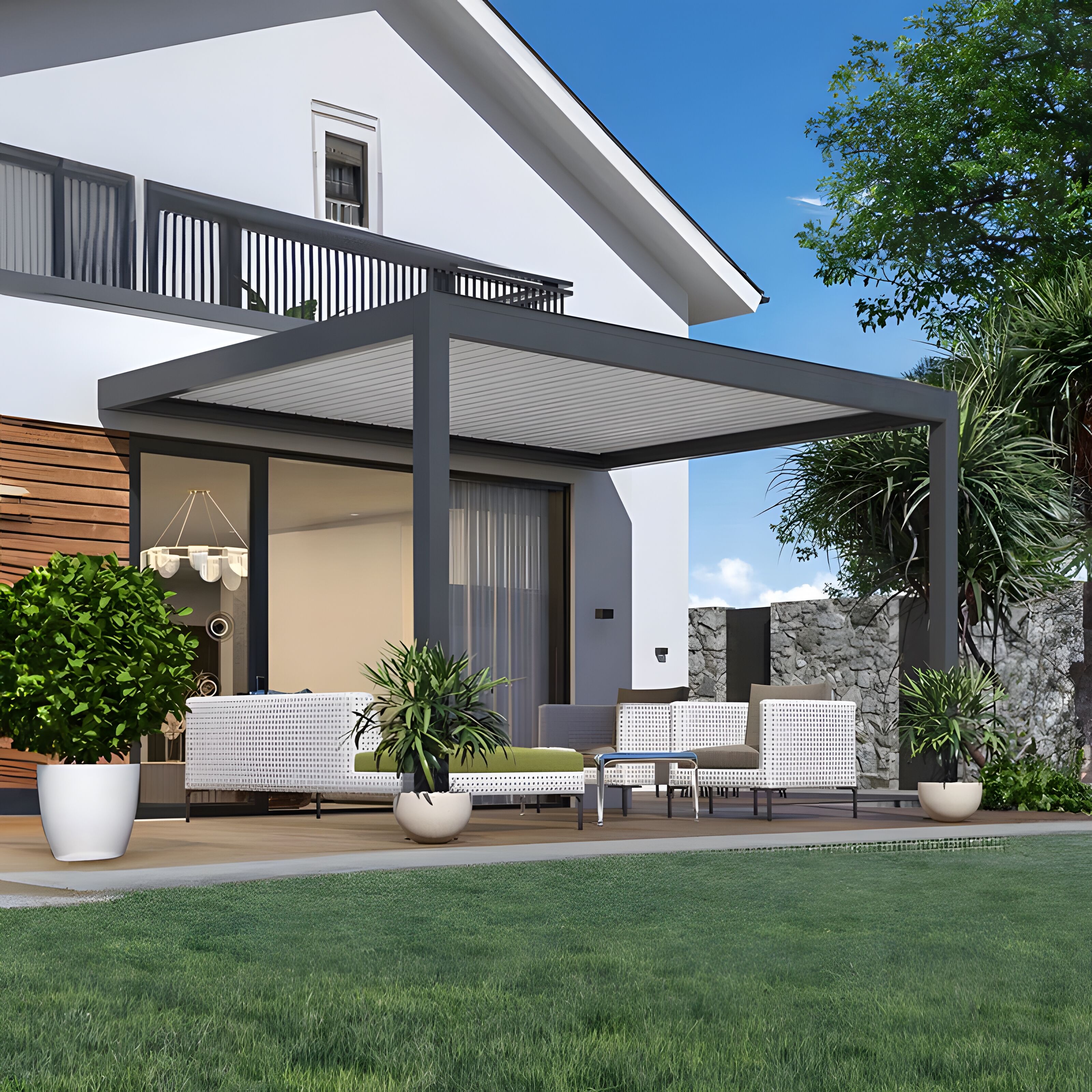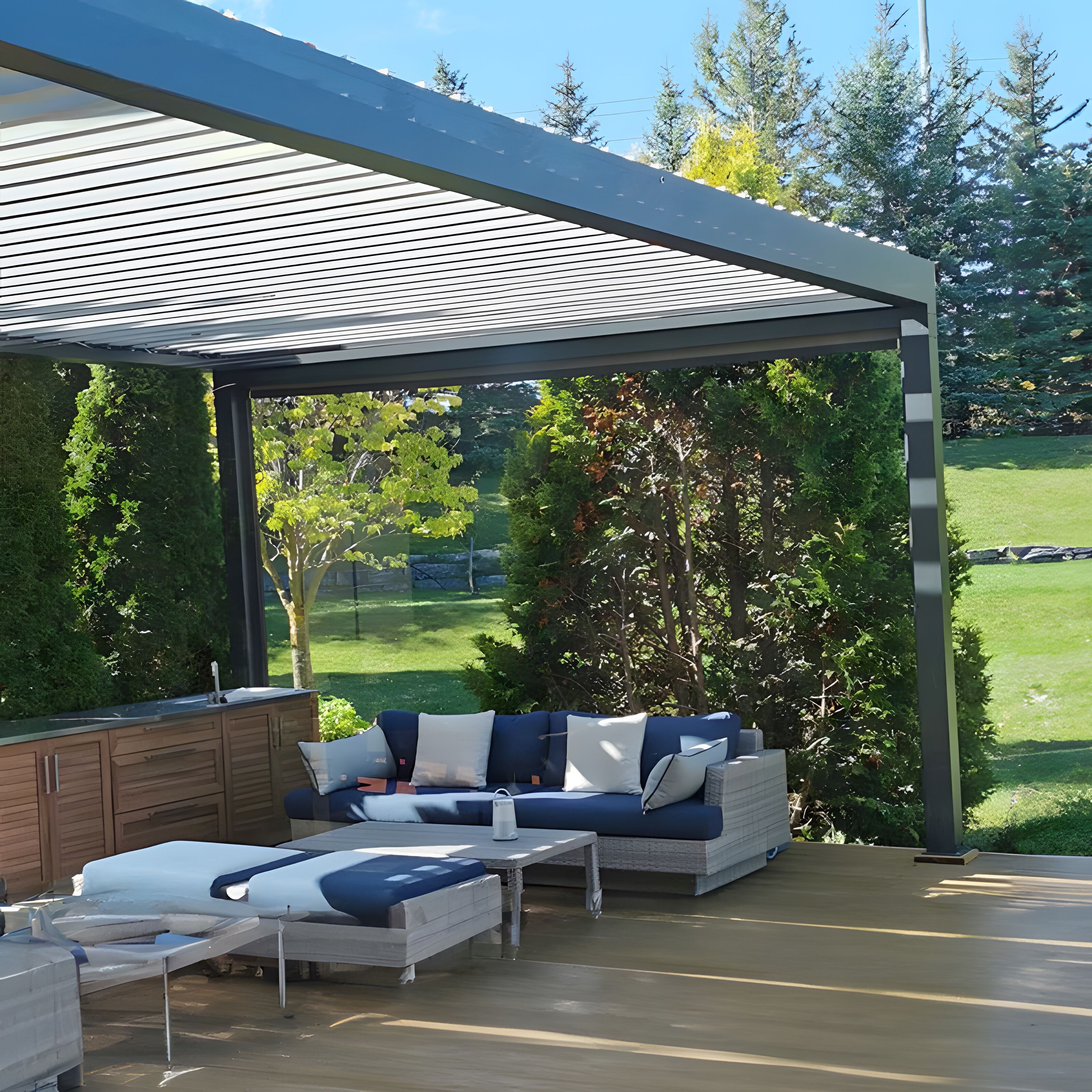Where Should You Place a Garden Pavilion Pergola? A Guide to Perfect Positioning
A garden pavilion pergola is more than just a structure—it’s a focal point that blends functionality, beauty, and outdoor living. Whether you envision it as a shaded spot for morning coffee, a backdrop for al fresco dinners, or a serene retreat to unwind amid nature, its placement can make or break its appeal. The right location enhances its purpose, while a poor choice might leave it underused or out of sync with your garden’s flow. Let’s explore how to find the ideal spot for your garden pavilion pergola, considering light, views, function, and more.
Follow the Light (But Avoid the Glare)
Sunlight is a key player in how you’ll use your garden pavilion pergola. Too much harsh midday sun can make it uncomfortable, while too little light might leave it feeling dim and unwelcoming. Start by observing your garden throughout the day to map light patterns.
Morning sun is gentle and invigorating, making it perfect for a breakfast nook or a quiet reading spot. If you want to enjoy early hours here, position the garden pavilion pergola where it catches eastern sunlight—think near a flower bed that blooms in the morning, so you can sip tea surrounded by color.
For afternoon use, consider partial shade. A spot with dappled light from overhead trees or filtered shade from a nearby wall can keep the space cool during hot summer afternoons. Western exposure, however, often brings intense late-day sun, which can feel oppressive; if your garden’s best views are to the west, pair the pergola with retractable shades or climbing plants like wisteria to soften the glare.
Don’t forget seasonal changes. A spot that basks in winter sun (when the angle is lower) can become a cozy retreat, while summer shade (from leafy trees) will keep it usable during heatwaves. Balancing light and shade is key to maximizing your garden pavilion pergola’s year-round appeal.
Frame the View (And Protect Privacy)
A garden pavilion pergola should feel like a “room with a view”—one that showcases your garden’s best features while shielding you from unwanted stares. Start by identifying your garden’s highlights: Is it a vibrant flower border, a trickling fountain, a mature oak tree, or a distant hillside? Position the pergola so that when you’re sitting inside, these focal points are front and center. For example, if you have a pond with water lilies, angle the pergola’s seating to face it—you’ll turn every meal or conversation into a scenic experience.

Privacy matters, too. No one wants to relax under their garden pavilion pergola while feeling overlooked by neighbors. If your garden is close to other homes, tuck the pergola behind a hedge, tall shrubs, or a trellis with climbing vines (like clematis or ivy) to create a natural screen. Alternatively, place it farther from property lines, using existing trees or garden structures (like a shed or a stone wall) to block .
Strike a balance: Your pergola should feel open enough to connect with the garden but enclosed enough to feel intimate. A well-positioned garden pavilion pergola becomes a vantage point for enjoying your outdoor space, not a fishbowl.
Stay Connected (But Not Too Close)
Your garden pavilion pergola shouldn’t exist in isolation—it should work with your home and other outdoor structures to create a seamless flow. Start by considering proximity to your house: A pergola that’s too far might feel disconnected, while one that’s too close could crowd your yard or block windows.
If you plan to use the pergola for outdoor dining, place it within steps of your kitchen. This makes it easy to carry food, utensils, and drinks, turning outdoor meals into a breeze. For a lounge space, position it near a living room or bedroom door, so you can slide open a window or walk out for a quick break in the fresh air.
Distance from other garden elements matters, too. Keep it far enough from a children’s play area to avoid noise if you’re seeking quiet, but close enough to a pool (if you have one) to serve as a shaded spot for drying off. Leave enough space around the pergola for pathways, so you can move freely without tripping over furniture or plants.
Think of your garden pavilion pergola as an extension of your home—close enough to be convenient, but spaced out enough to feel like a distinct outdoor oasis.
Match the Function to the Spot
How you plan to use your garden pavilion pergola will dictate its perfect position. Start by defining its primary role: Is it a dining area, a lounge, a workspace, or a place to grow climbing plants?
For dining: Prioritize a flat, level surface (you don’t want wobbly tables!) and proximity to the kitchen (as mentioned earlier). Look for a spot with good light for daytime meals and consider overhead lighting (like string lights or a pendant) for evening use. Avoid areas with strong winds, which can blow away napkins or chill food quickly.
For lounging: Seek out a sheltered, quiet corner. Shade is key here—position the pergola under a large tree or near a wall that blocks wind. Soften the space with cushions and outdoor rugs, and make sure the view is calming (think greenery over a busy street).
For gardening: If you want your garden pavilion pergola to support climbing plants (roses, grapes, or jasmine), choose a spot with plenty of sunlight—most flowering vines need 6+ hours a day. Ensure the structure is sturdy enough to bear the weight as the plants grow, and position it where the vines can spill over gracefully, enhancing the pergola’s beauty.
By aligning the pergola’s location with its purpose, you’ll ensure it’s not just a decorative piece, but a hardworking part of your garden.
Check the Terrain (And Drainage!)
Even the most beautiful garden pavilion pergola will fail if placed on uneven or waterlogged ground. Before settling on a spot, assess the terrain:
Avoid low-lying areas: These collect rainwater, which can rot the pergola’s posts, attract mosquitoes, and make the space unusable after storms. Look for slightly elevated ground where water drains away naturally.
Smooth out slopes: A gentle slope is manageable with leveling (using gravel or concrete pads), but a steep incline will require more work (like building retaining walls) and may make the space feel awkward. Save yourself the hassle by choosing relatively flat ground.
Test drainage: After a rainstorm, check which parts of your garden dry quickly and which stay soggy. Aim for a spot that drains well—if needed, add gravel under the pergola’s base to improve water flow.
Consider ground cover: Grass is soft but can get muddy; gravel is durable but hard underfoot; concrete is low-maintenance but feels less natural. Choose a surface that suits your use (e.g., concrete for dining, gravel for lounging) and ensure the pergola’s posts are anchored securely to prevent shifting.
A stable, dry foundation will protect your garden pavilion pergola from damage and keep it safe and comfortable for years.
FAQ: Common Questions About Garden Pavilion Pergola Placement
1,Can I place a garden pavilion pergola directly under a tree?
Yes, but with caution. Trees provide natural shade, but falling leaves, sap, or branches can damage the pergola or create extra cleanup. Ensure the tree is healthy (no rotting branches) and leave enough space between the tree and pergola posts to avoid root damage as the tree grows.
2,How far should a garden pavilion pergola be from my house?
Typically, 6–10 feet is ideal. This keeps it close enough for convenience but far enough to prevent water from the roof (during rain) from soaking the pergola, and avoids blocking windows or vents. Check local building codes—some areas have rules about structures near property lines or homes.
3,Do I need planning permission to place a garden pavilion pergola?
It depends on your location and the pergola’s size. Many areas allow small pergolas (under 10 feet tall) without permission, but larger structures or those near property lines may require approval. Contact your local council to confirm.
4,Can a garden pavilion pergola be placed on grass?
Yes, but it’s best to anchor the posts to concrete footings (even partially buried) to prevent them from shifting, especially in wet or windy weather. You can also lay landscape fabric under the grass to reduce weeds.
5,Should my garden pavilion pergola face a specific direction?
It depends on your goal. Facing east catches morning sun (great for breakfast), south gets all-day sun (good for plants but may need shade in summer), west has afternoon sun (intense but warm in winter), and north offers gentle, indirect light (ideal for heat-sensitive use).
Table of Contents
- Where Should You Place a Garden Pavilion Pergola? A Guide to Perfect Positioning
-
FAQ: Common Questions About Garden Pavilion Pergola Placement
- 1,Can I place a garden pavilion pergola directly under a tree?
- 2,How far should a garden pavilion pergola be from my house?
- 3,Do I need planning permission to place a garden pavilion pergola?
- 4,Can a garden pavilion pergola be placed on grass?
- 5,Should my garden pavilion pergola face a specific direction?



